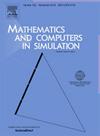空间环境中互动种群模型的非恒定稳定状态和模式形成研究
IF 4.4
2区 数学
Q1 COMPUTER SCIENCE, INTERDISCIPLINARY APPLICATIONS
引用次数: 0
摘要
本手稿阐述了对相互作用种群空间模型复杂动力学的研究。我们讨论了所提出的时空系统解的存在性和有界性。在合适的 Lyapunov 函数的帮助下,分析了所提系统共存稳态的全局稳定性。我们提供了模型正非常数解存在与不存在的结果。利用最大值原理,我们得到了正稳态的先验估计值,以确定非恒定正稳态的不存在性。借助 Leray-Schauder 度理论研究了非恒定正稳态的存在性。在相应的时间模型中,对共存稳态的稳定性和霍普夫分岔进行了简要重述,观察到了类似气泡的结构。分析了霍普夫分岔的发生,并通过扩散驱动不稳定性分析确定了图灵模式形成的不同条件。为了弄清饱和采集对图灵模式的影响,我们进行了详细的数值模拟。此外,还研究了各自领域中的图灵和非图灵模式。最后,通过相关的数值示例和相应的图表简要说明了图灵-霍普夫分岔的标准,从而更好地诠释了这项工作。本文章由计算机程序翻译,如有差异,请以英文原文为准。
The study of non-constant steady states and pattern formation for an interacting population model in a spatial environment
This manuscript accounts for an investigation of the complex dynamics of a spatial model for interacting populations. We discuss the existence and boundedness of solutions for the proposed spatio-temporal system. The global stability of the co-existing steady state of the proposed system is analyzed with the help of a suitable Lyapunov function. We provide results on the existence and non-existence of positive non-constant solutions of the model. The priori estimate for the positive steady state is obtained for the nonexistence of the non-constant positive steady state by using the maximum principle. The existence of a non-constant positive steady state is studied with the help of Leray–Schauder degree theory. The stability and Hopf bifurcation are briefly revisited for the co-existing steady state in the corresponding temporal model, where a bubble-like structure is observed. The onset of Hopf bifurcation has been analyzed, and different conditions for the formation of the Turing pattern have been established through diffusion-driven instability analysis. Numerical simulations are performed in detail to figure out the effects of saturated harvesting on Turing patterns. The Turing as well as non-Turing patterns in their respective domains are also examined. Finally, the criteria of Turing–Hopf bifurcation is briefly demonstrated with relevant numerical examples and corresponding plots that give a better illustration of this work.
求助全文
通过发布文献求助,成功后即可免费获取论文全文。
去求助
来源期刊

Mathematics and Computers in Simulation
数学-计算机:跨学科应用
CiteScore
8.90
自引率
4.30%
发文量
335
审稿时长
54 days
期刊介绍:
The aim of the journal is to provide an international forum for the dissemination of up-to-date information in the fields of the mathematics and computers, in particular (but not exclusively) as they apply to the dynamics of systems, their simulation and scientific computation in general. Published material ranges from short, concise research papers to more general tutorial articles.
Mathematics and Computers in Simulation, published monthly, is the official organ of IMACS, the International Association for Mathematics and Computers in Simulation (Formerly AICA). This Association, founded in 1955 and legally incorporated in 1956 is a member of FIACC (the Five International Associations Coordinating Committee), together with IFIP, IFAV, IFORS and IMEKO.
Topics covered by the journal include mathematical tools in:
•The foundations of systems modelling
•Numerical analysis and the development of algorithms for simulation
They also include considerations about computer hardware for simulation and about special software and compilers.
The journal also publishes articles concerned with specific applications of modelling and simulation in science and engineering, with relevant applied mathematics, the general philosophy of systems simulation, and their impact on disciplinary and interdisciplinary research.
The journal includes a Book Review section -- and a "News on IMACS" section that contains a Calendar of future Conferences/Events and other information about the Association.
 求助内容:
求助内容: 应助结果提醒方式:
应助结果提醒方式:


